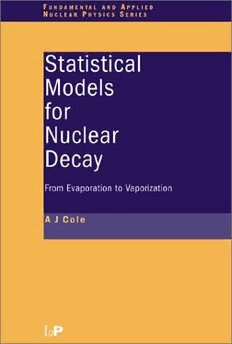
Statistical Models for Nuclear Decay: From Evaporation to Vaporization (Series in Fundamental and Applied Nuclear Physics) PDF
349 Pages·2000·3.617 MB·English
Most books are stored in the elastic cloud where traffic is expensive. For this reason, we have a limit on daily download.
Preview Statistical Models for Nuclear Decay: From Evaporation to Vaporization (Series in Fundamental and Applied Nuclear Physics)
Description:
Statistical Models for Nuclear Decay: From Evaporation to Vaporization describes statistical models that are applied to the decay of atomic nuclei, emphasizing highly excited nuclei usually produced using heavy ion collisions. The first two chapters present essential introductions to statistical mechanics and nuclear physics, followed by a description of the historical developments, beginning with the application of the Bohr hypothesis by Weisskopf in 1937. This chapter covers fusion, fission, and the Hauser-Festbach theory. The next chapter applies the Hauser-Festbach theory using Monte Carlo methods and presents important experimental results. Subsequent chapters discuss nuclear decay at high excitation energies, including the theories and experimental results for sequential binary division, multifragmentation, and vaporization. The final chapter provides a short summary and discusses possible paths for further research.
See more
The list of books you might like
Most books are stored in the elastic cloud where traffic is expensive. For this reason, we have a limit on daily download.
